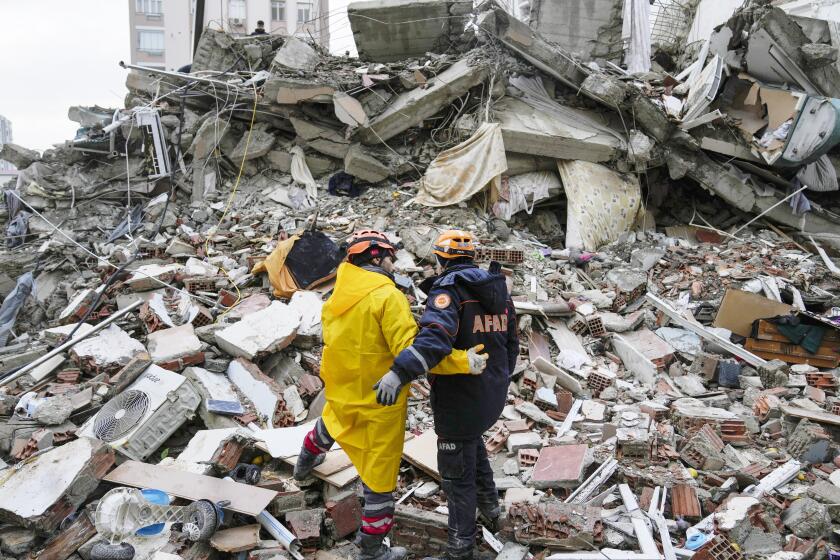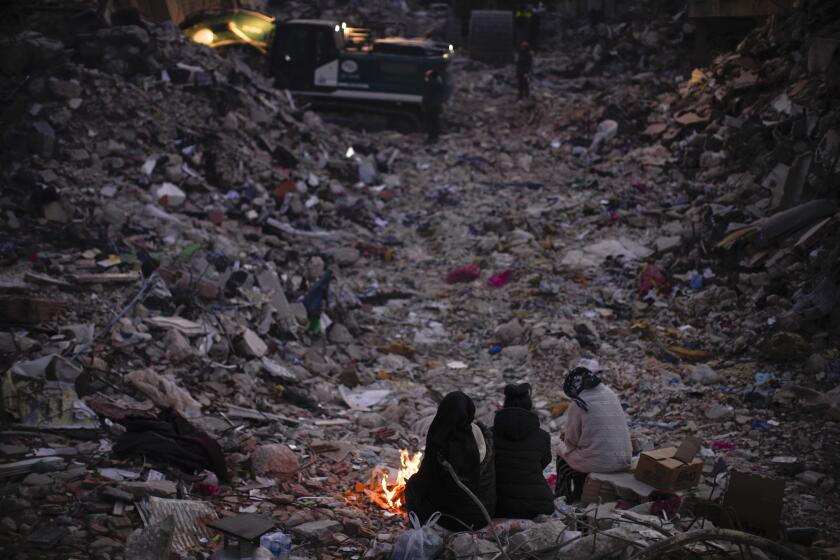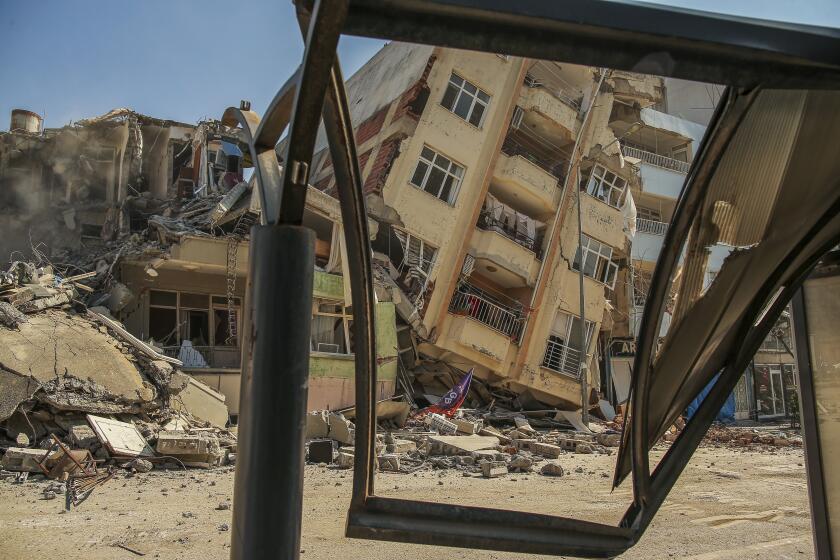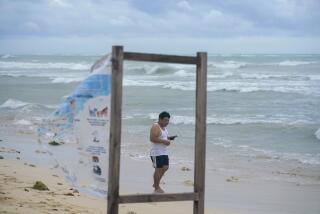Grief and fear of more shaking follow deadly quake on Ecuador’s southwest coast
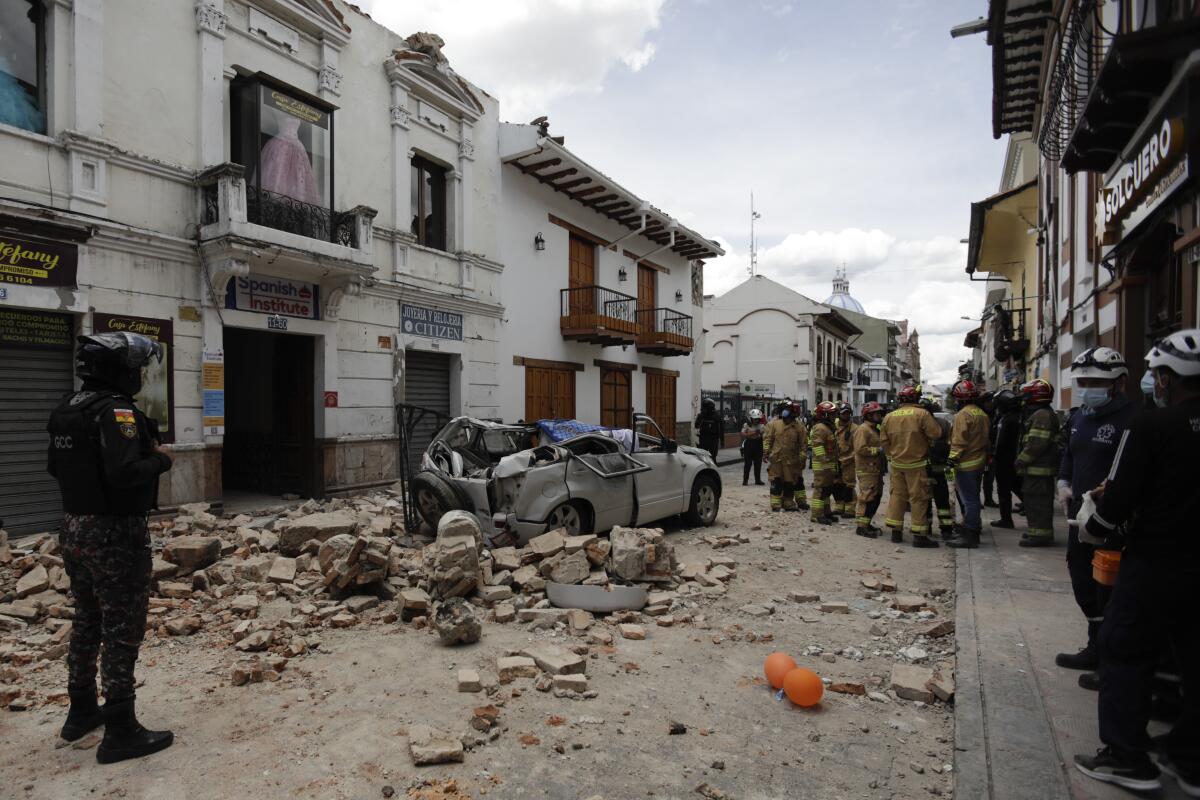
- Share via
QUITO, Ecuador — Some affectionately call Machala the “Banana Capital of the World.” The port community on Ecuador’s Pacific coast is home to about a quarter-million people and normally bustles with commercial activity. But not after the weekend’s deadly quake.
Grief hung in the air Sunday, a day after a powerful temblor rocked the city, toppling homes and buildings along the coast and as far away as the Ecuadorian highlands and even parts of Peru.
Rubble covered some streets of Machala. Neighbors held simple funerals to bury the dead. A pier was gone. And a day after the quake that killed nine residents alone along this hard-hit coast, many in Machala were feeling anguished and uneasy.
“The city is quiet; fear and mourning are felt,” resident Luis Becerra said. “You feel the pain, the drama, wherever you go. Everyone is alert, with great fear in case” of a major aftershock.
The quake, which the U.S. Geological Survey reported at magnitude 6.8, killed at least 15 people and injured more than 445 others. Fourteen died in Ecuador, and one in Peru.
The quake damaged and brought down hundreds of homes and buildings in vastly different communities, both in coastal areas and the highlands. But in Ecuador, regardless of geography, many of the homes that crumbled had much in common: They were old, did not meet modern seismic building standards and often housed poor inhabitants.
The flaws of non-ductile concrete construction are found across California, with many buildings having not been evaluated or retrofitted and at risk of collapse in a serious earthquake.
Yajaira Albarracín, Graciela Chila, Silvina Zambrano Chila and two children died under the rubble of their home in a low-income neighborhood of Machala. On Sunday, a few neighbors stopped by a tent where the caskets of the women where set out with floral arrangements and a crucifix. Some relatives said rescuers found the bodies of the women and children as if they had been clutching one another when disaster struck.
The earthquake was centered just off the Pacific coast, about 50 miles south of Guayaquil, Ecuador’s second-largest city. Of the country’s 14 victims, 12 died in the southwest coastal state of El Oro, which includes Machala, and two in the highlands state of Azuay.
Ecuador is particularly vulnerable to earthquakes. In 2016, a quake centered farther north on the coast killed more than 600 people.
Machala resident Hamilton Cedillo said Sunday that he and his family barely slept in the hours after Saturday’s quake, fearful of deadly aftershocks. They have come up with an evacuation plan and watched videos on how to protect themselves should another quake strike.
A month after devastating quake, hundreds of thousands of people in Turkey and Syria still have ‘extensive humanitarian needs,’ U.N. official says.
“I am afraid of leaving and that my family will be left here alone at home,” Cedillo said.
Pope Francis, who is from Argentina, offered prayers for the victims during his weekly Sunday noon blessing.
“I’m close to the Ecuadorian people and assure them of my prayers for the dead and suffering,” Francis said.
Ecuador’s government issued an emergency declaration covering the roads in Azuay, where quake debris cut off several arteries and worsened already poor conditions attributed to the winter’s rainstorms. One of the quake victims there was a passenger in a vehicle crushed by rubble from a house in the community of Cuenca.
The guide to earthquake readiness and resilience that you’ll actually use.
In El Oro, according to the Risk Management Secretariat, Ecuador’s emergency-response agency, several people were trapped under rubble or in damaged buildings.
Quito-based architect Germán Narváez said houses hit hardest tend to be poorly built, lacking solid foundations and deficient in structure and technical design. He added that the most vulnerable homes are often old and built with materials such as adobe, once frequently used in the region.
“At critical moments of seismic movements, they tend to collapse,” he said.
Juan Vera lost three relatives when the earthquake brought down his niece’s home. The government has offered to pay for the woman’s funeral and those of her baby and her partner.
L.A. County’s proposed earthquake rules would require certain older concrete buildings in unincorporated areas, and those owned by the county, to be retrofitted.
Now, Vera wonders why local authorities allowed his relatives to live there to begin with, saying the municipality should better regulate building conditions and ensure that only those which are really safe are rented out or occupied.
“Because of its age, that building should have been demolished already,” Vera said of the place where his relatives died.
More to Read
Sign up for Essential California
The most important California stories and recommendations in your inbox every morning.
You may occasionally receive promotional content from the Los Angeles Times.
